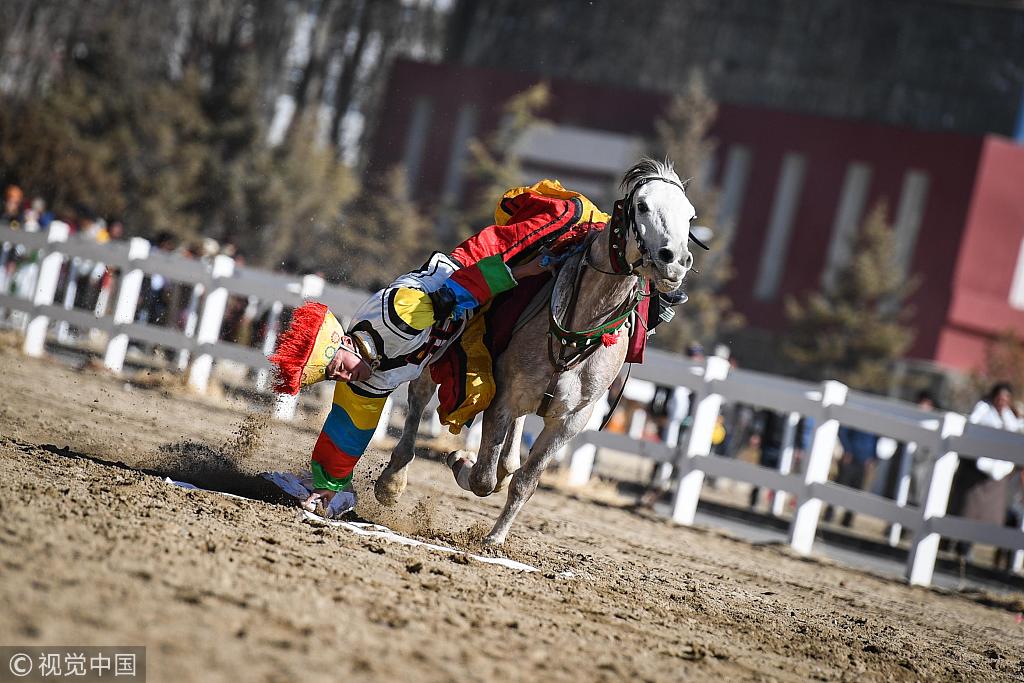Horses still hold importance in Tibetans' lives
Xinhua | Updated: 2019-02-18 09:17

During ancient times on the Tibetan plateau, as one folk epic describes it, any tribe member who won a horse race would be perceived worthy of being named chief.
However, that is not the case in modern times. Urgyen, in his auspicious hat, green blouse and red trousers, was surrounded by hundreds of villagers congratulating him after winning a horse race in Ngari prefecture, Tibet autonomous region.
The Epic of King Gesar tells the story of an 11th century Tibetan demigod who defeated enemies on horseback, helping to save his people. This story has been passed down through word-of-mouth by singers and also by illiterate herders and farmers.
This story is well-known among Tibetans, and it is believed to be the reason why horse racing competitions are still held across Tibet today.
"I'm wearing the same outfit that the demigod wore as described in the epic," said 32-year-old Urgyen.
After his win, Urgyen became the pride of his hometown and one of the most respected people among the villagers.
Living on the "roof of the world", Tibetans used to rely on horses to get around.
Urgyen remembers that people "couldn't go anywhere without a horse" during his childhood.
"Back in the 1970s, we rode horses for so long that no one could walk when they finally got off the horse," said Darlha, an official with the local government.
Since 1990, traveling on horseback has become less common in plateau life, as most villages are connected to modern road networks these days.
"Everyone has motorbikes and cars now. We don't travel on horseback anymore," Urgyen said, adding that he even drives to the racetrack with his horse pulled in a trailer behind his pickup truck. "It used to take days, but now it only takes hours."
Urgyen's family used to own a dozen horses. Now, they just have four, and they are only used for racing.
Chogyal Sangmo lives in a neighboring village and has been riding horses for as long as she can remember. When she was a teenager, she cried the whole night after her father decided to sell all their horses.
A few years ago, Chogyal Sangmo became the first woman in the village to obtain a driver's license.
When Chogyal Sangmo drove all the way back from the capital Lhasa over 1,000 kilometers away, villagers offered her hada, or a traditional Tibetan ceremonial scarf, to show their admiration and blessings. "They thought it was incredible!" she said.
Those who own fast racehorses are widely respected on the grasslands, as they are a symbol of great wealth. Urgyen's winning horse is worth 30 yaks or 300,000 yuan ($44,770).
However, he always turns down offers to buy his horse.
Meanwhile, horses have regained their status as a mode of transport in some places.
Gyumey Dorje lives at the foot of Mount Gang Rinpoche, a sacred mountain for Tibetans and a popular tourist attraction.
Villagers there offer services such as horseback riding or goods transfer up and down the mountain. "I make more than I've ever earned before," said Gyumey Dorje, who believes riding horses again could bring about a better life for Tibetans.
"The horse is no common livestock," said Ngawang Tenzin from the local cultural authority.
"The changing status of horses reflects the development of Tibet."
























